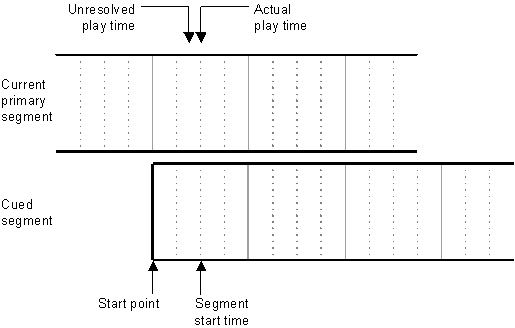
| Microsoft DirectX 8.1 (Visual Basic) |
This section covers various aspects of timing in the playing of segments.
To clarify the relationship between times within segments and times within the performance, the following terms are used throughout this section:
Start point
The first point in the segment that can be a segment start time. By default this value is 0, indicating the beginning of the segment. However, it can be changed by the application.
Segment start time
The point in a segment where it begins producing sounds. This time is usually the same as the start point, but can be later if the start point is deliberately aligned to a play time that is in the past.
Play time
The point in the performance where a new segment's start point is cued. In the DirectMusic API, this time is sometimes called start time.
Start marker
A marker indicating a valid start time in a segment. This can be an enter switch point in the marker track, or a variation switch point in a
Play marker
A marker in the marker track of a control segment indicating where another segment's start point can be cued.
Note Start markers and play markers are placed in the segment by the author and cannot be changed by the application.
Segments normally play from the beginning. You can make a segment start from another point by using the DirectMusicSegment8.SetStartPoint method. This start point is used whenever the segment is played.
If a repeat count is set by using DirectMusicSegment8.SetRepeats, the entire segment repeats that number of times, unless a loop has been defined by a call to DirectMusicSegment8.SetLoopPoints, in which case only the part of the segment between the loop points repeats.
The play time is determined by two parameters of DirectMusicPerformance8.PlaySegmentEx:
Rather than forcing the segment start time to the next grid, beat, or measure in the control segment, you might want the segment to start playing sooner, yet still match the rhythm of the current segment. You can make the segment do so by cuing its start point to a rhythmic boundary that has already passed. The rhythm in the cued segment is thus aligned with that in the current segment, and the new segment can start playing immediately.
To cue the segment in the past, use the DMUS_SEGF_ALIGN flag. Add one of DMUS_SEGF_GRID, DMUS_SEGF_BEAT, DMUS_SEGF_MEASURE, or DMUS_SEGF_SEGMENTEND to cue the start point of the segment at the appropriate rhythmic boundary. Alternatively, you can use DMUS_SEGF_MARKER to align the start point to the most recently played play marker in the control segment.
Note Combining DMUS_SEGF_ALIGN with DMUS_SEGF_SEGMENTEND causes the beginning of the cued segment to be aligned with the beginning of the current segment.
Of course, when the start point is in the past, the segment start time has to be adjusted to fall in the present or the future. The performance uses the following rules to determine the segment start time. In all cases, "next" means "next possible"—that is, within the part of the segment that does not fall in the past.
| Flag | Purpose |
| DMUS_SEGF_VALID_START_BEAT | Put the segment start time on the next beat. |
| DMUS_SEGF_VALID_START_GRID | Put the segment start time on the next grid. |
| DMUS_SEGF_VALID_START_MEASURE | Put the segment start time on the next bar line. |
| DMUS_SEGF_VALID_START_TICK | Put the segment start time at the earliest possible point. |
Play markers and start markers allow greater flexibility in the cuing of segments, especially
For information on how tempo changes can affect segment start times, see Clock Time vs. Music Time.
The following diagram shows how the timing is determined for a segment cued with the DMUS_SEGF_MEASURE, DMUS_SEGF_ALIGN, and DMUS_SEGF_VALID_START_BEAT flags. The solid vertical lines are measure boundaries, and the dotted lines are beat boundaries. The start point of the segment is aligned with the previous measure boundary in the current primary segment. The segment start time falls at the first beat in the cued segment after the unresolved play time.

Some events have both a logical time and an actual time. The actual time is when the event will take place, and the logical time represents the musical position where it belongs.
For example, a segment might contain a program change that belongs to the start of a beat. The logical time is the start of the beat. However, you want to make sure the program change takes place before the note on the beat is played, so you assign it a physical time that's a little earlier.
If the segment loops to the logical time (the start of that same beat), the program change will still go out.